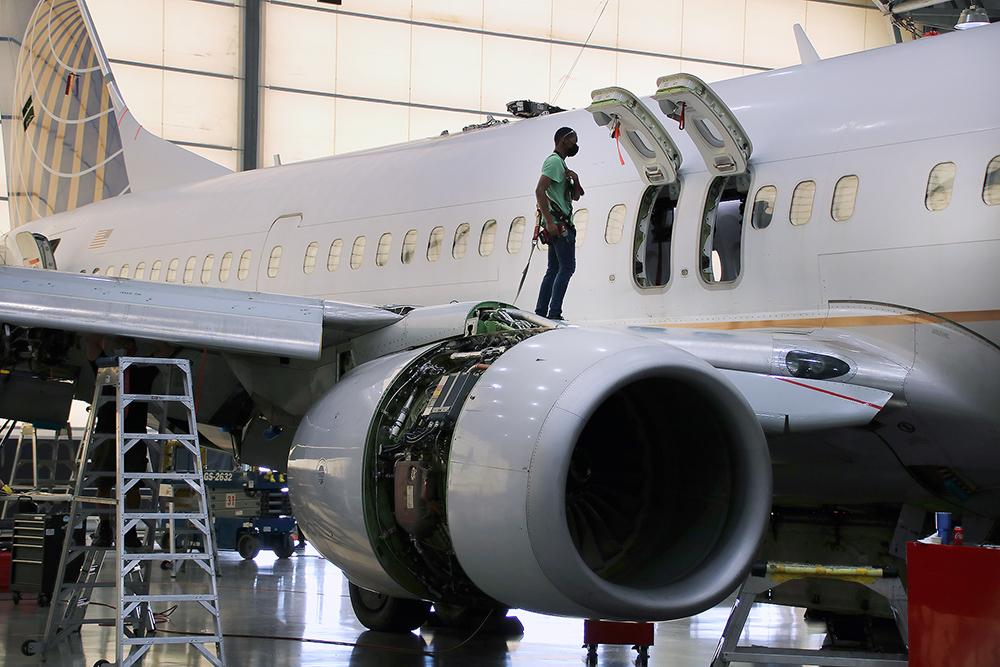
OSHA has recorded more than 30 severe injuries to aircraft mechanics over the last seven years due to falls from various heights.
The topic of safety in aircraft maintenance tends to focus on that of aircraft and passengers, but there is another side to this important value: the safety of aircraft mechanics themselves.
Safety is important to mechanics, of course, but also to shops and airlines, which must bear the financial consequences of accidents. And safe work environments may be increasingly important to attracting new mechanics.
However, unless rigorous safety practices are adhered to, aircraft maintenance is inherently risky. The hazards of aircraft maintenance—and workman’s compensation insurance rates—are about the same as for construction workers, a notoriously risky occupation, according to John Goglia, once a mechanic himself, a former member of the National Transportation Safety Board and now chairman of the Professional Aviation Maintenance Association.
Goglia notes that safety procedures have generally been improving since he worked as a mechanic, but there are still some worrisome spots.
The best data on maintenance accidents comes from the U.S. Occupational Safety and Health Administration’s (OSHA) Severe Injury Reports, now available from January 2015 through February 2022. OSHA defines severe injuries as those involving amputation, loss of an eye or other injury requiring overnight hospitalization.
Before COVID-19, these severe injuries occurred at rates of 9-19 per year. During the dramatic traffic and MRO drop of 2020, only ten such injuries were reported, and in 2021 the count was 18. Over more than seven years, from January 2015 through the end of February 2022, 110 severe mechanic injuries were reported, or an average of less than 14 annually.
More than 30 severe injuries recorded by OSHA were falls from various heights. Goglia says falls are among the most dangerous hazards in maintenance. Especially dangerous are falls when mechanics are working on vertical stabilizers high above the ground. These mechanics should be wearing harnesses, but that was not always the practice.
Goglia says another dangerous job is working inside fuel tanks, where vapors can threaten mechanics. A United Airlines mechanic died in 1996, overcome by fumes while inside the wing fuel tank of a Boeing 767. Stricter safety rules were afterwards imposed.
OSHA reports an STS mechanic, inside a fuel tank, had a high-pressure water hose whip around, lacerating his arm, which required hospitalization in 2020. And an AAR mechanic removing fuel tank panels fell from an eight-foot ladder in 2021. In late 2022, a FedEx mechanic had to be rescued and revived at Los Angeles International Airport after being rendered temporarily unconscious. It is not clear whether safety rules were violated, or this accident occurred despite the rules. FedEx declined to comment on the accident.
Engine removals, especially outside properly equipped facilities, can also be risky, according to Goglia, but OSHA does not report any severe removal mishaps in its limited timeframe.
According to OSHA data, with one exception, airlines appear to have fairly safe work environments. One accident each occurred at Lufthansa, Southwest, United and Mesa from 2015 through early 2022. “Most airlines are self-insured with high deductibles, and bear the costs,” Goglia notes. “They have independent safety departments and are very concerned with safe processes. Airlines tend toward more rigid training in safety.”
Airlines also tend to have more experienced mechanics, and that promotes safety. Older mechanics are more cautious, according to Goglia. “Younger ones have energy and think, ‘I can take risks.’ But they don’t understand the risks,” he adds.
However, one carrier, American Airlines, reported eight severe injuries from 2015 to early 2022. Deducting a heart attack and a slip on parking lot ice, six of American’s injuries clearly related to maintenance itself.
American does have the largest fleet in the world and a huge maintenance staff, outsourcing the lowest portion of maintenance of any U.S. carrier. When contacted, American declined to comment on the frequency of its accidents.
Most major U.S. MRO shops did not have more than one injury, if any. But staffing companies G2 Secure Staff and M1 Support Services reported four and five, respectively. And fixed base operator Signature Aviation reported five severe injuries, while ground handler Swissport USA counted ten. Cargo handler Worldwide Flight Services reported five such accidents.
These companies do a lot of line maintenance. Goglia says line maintenance can be riskier than hangar work, since hangars tend to be well equipped and mechanics are subject to more supervision. “There are more eyes to prevent mistakes,” he says. In contrast, line maintenance can entail more pressure to get work done and aircraft turned around quickly.
Overall, the largest number of injuries have been fractures—almost 40% of the total. Next come amputations, at about a quarter. Other accidents involved concussions, cuts, lacerations, hernias, soreness, strains or other injuries. The most frequently damaged body parts have been fingertips, hurt in 27 accidents, followed by hips, heads, arms ankles and backs.



